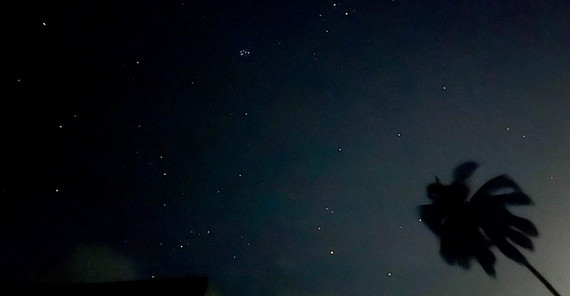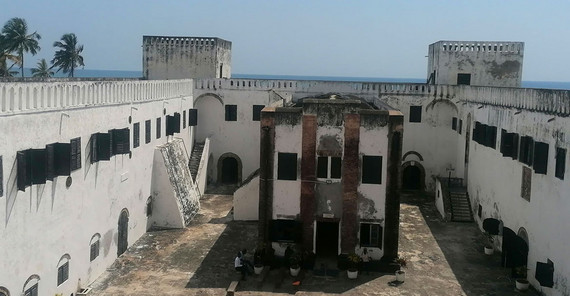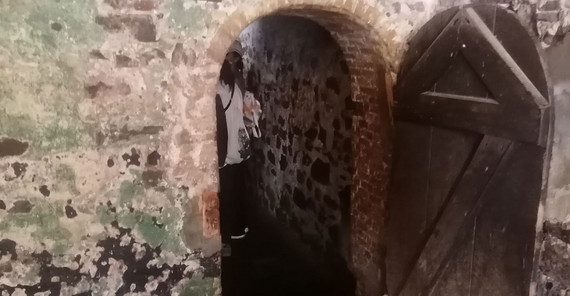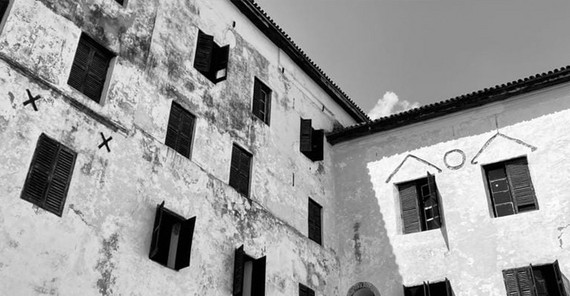Addition to last night: Our first night at the new accommodation “The Beach House Afiki” in Ankwande turns out to be exciting, because of a power outage. But our discussion about Ghana’s education system is replaced by a beautiful night sky with countless stars (picture 1). We illuminate our way to our way to warm rooms with a flashlight, because the air-condition and the fans are not working.
Day 6: Elmina Castle
After a mixed night with little sleep and all the more heat, we are delighted when the electricity is back on the next day. A delicious, freshly prepared breakfast with a view of the sea and palm trees later, we set off for Elmina Castle with mixed feelings. It was built in 1482 by the Portuguese on the coast of Ghana, in a place they named Elmina. On the way there, we drive through narrow alleys lined with countless shacks. From these, locals sell drinks, freshly prepared and dried food, clothing and hygiene products. Many children wave at us and are apparently very surprised by our visit. We can see the white fortress overlooking the small fishing village from afar. When we arrive at the parking lot, we are approached by locals. They ask what our names are and whether we want to buy some of their products. Some feel a little pressured, but the group quickly makes its way into the former slave fortress. There we are given an impressive and emotional guided tour. Elmina Castle was the first European fortress south of the Sahara and the central trading and military base of the Portuguese, Dutch and later the British. In addition to gold, ivory and spices, slaves were also traded. While our tour guide tells us more about the history of the place, he "locks" us in two different cells - one after the other. In the first, the air circulates, there is a kind of window that provides light and the iron door has lots of peepholes. Soldiers who broke the rules or committed crimes against local women were locked up here for a few hours. The second cell is far more drastic: dark and stuffy, oppressive. Slaves were left here to die without food, water or light.
We continue into the catacombs, where male and female slaves were held separately. We stand in a dark and damp room measuring around 30 square meters with vaulted ceilings. We learn that 400 men were housed here. Again, we feel extremely uncomfortable. We walk bent over through a narrow corridor into the next room, the point of no return. This is where the slaves were transported en masse through a narrow window directly onto the ships and never returned.
The women's dungeon is just as large as the men's. However, there is an inner courtyard from which a staircase leads up to the governor's chambers. At the time, the governor stood on the balcony and regularly selected women who had to accompany him to his chambers. If a slave refused, she had to carry a 28-kilogram iron ball chained to her for days on end, standing in the sweltering heat. Horrific images arise in our minds and, heavy-hearted , we make our way to the two upper floors. The officers stayed on the first floor. The rooms are large, flooded with light and the sea breeze makes you forget the hot temperatures. On the top floor are the governor's bedchamber and two (!!!) living rooms, each of which is almost as large as the catacombs below. We quickly realize how much space a single person can take up, while two floors below, slaves were crammed together like animals in inhumane conditions. Many of these people refused to eat or drink. They chose death so that the colonial masters could not make a profit from them. After these painful impressions, we all need to take a deep breath.
On the way to our bus, we are approached again by the locals, who give us beautiful shells with our names on them and insist that we get them for free. We donate money to the local soccer club and set off on our return journey.
Exhausted from the day, we eat dinner together and then fall into bed in our now pleasantly cool rooms.
Day 7: individual research
After the impressions of the last week, we decided together to process the experiences of the past few days and devote ourselves to our individual research projects.
To the travel diaries published so far (in German): https://www.uni-potsdam.de/de/up-entdecken/upaktuell/up-unterwegs-reisetagebuecher




